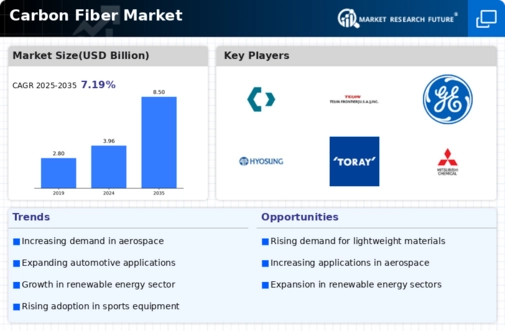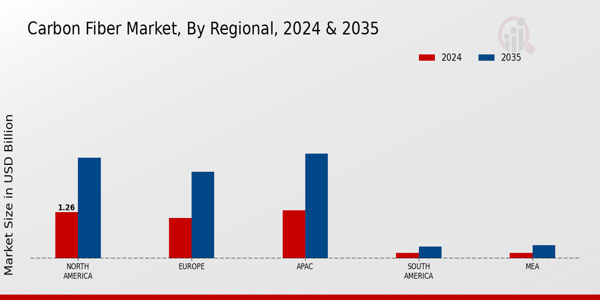Market Analysis
Carbon Fiber Market (Global, 2024)
Introduction
Industry has come to appreciate the properties of this material, which include lightness, strength, resistance to oxidation, and stability to heat. As a result, carbon fibre is being used more and more often in a wide range of applications, from aeronautics and the automobile to sports equipment and the green economy. The growing demand for lightweight and resistant materials is driving research and investment in the technology of manufacturing carbon fibre, which is resulting in improved manufacturing processes and cost reductions. Also, the need to respect the environment is putting pressure on manufacturers to develop eco-compatible products and methods of recycling, which will open up new possibilities for the market. The development of materials is still in its infancy, and the carbon fibre market is expected to play a major role in the future of many industries, which will make it a strategic asset for all those who want to benefit from it.
PESTLE Analysis
- Political
- In 2024, governments of the world are increasingly promoting the use of advanced materials like carbon fiber, because of their light weight and high strength. The United States, for example, has allocated a budget of around 150 million dollars to develop advanced manufacturing, which includes carbon fiber composites, as part of its strategy to enhance the country’s manufacturing capabilities. Trade barriers are changing, with the European Union imposing tariffs on certain imported carbon fiber products, which could affect the price and availability of the material.
- Economic
- The market for carbon fiber is influenced by the economic conditions of the major industries that consume carbon fiber. In 2024, the aerospace industry will spend $20 billion on carbon fiber components, driven by the demand for fuel-efficient aircraft. The automotive industry will invest about $10 billion in carbon fiber to meet the emissions standards and improve vehicle performance. In the automobile industry, the use of lightweight materials is increasingly important.
- Social
- The carbon fibre market in 2024 will be influenced by the consumers’ awareness of the environment and of the need to act sustainably. According to a survey, 65% of consumers are willing to pay more for products made from sustainable materials, including carbon fibre. The producers have started to search for eco-friendly production methods, such as the use of waste from the manufacture of carbon fibre. The use of waste from the manufacture of carbon fibre could lead to savings of up to 30% in production costs and appeal to the consumers.
- Technological
- The market for carbon fibre is changing rapidly with technological innovations in production and application. In 2024, the introduction of automated fibre placement technology is expected to boost the efficiency of carbon fibre production by 40 per cent, enabling manufacturers to produce more complex shapes at lower cost. In addition, new resins that can withstand higher temperatures are increasing the potential for carbon fibre in industries such as automobiles and aeronautics where performance under extreme conditions is paramount.
- Legal
- The regulations relating to the use of carbon fibres are becoming more and more stringent, particularly in the aeronautical and automobile industries. In 2024, the American Federal Aviation Authority (FAA) requires all new aircraft to be constructed to a new standard of safety, which involves the use of a certified material. This new regulation will affect around 1,200 aircraft manufacturers and suppliers, who will have to comply with new certification and testing procedures in order to ensure the integrity and safety of the material.
- Environmental
- Production methods are also under scrutiny. There is increasing pressure on the industry to adopt sustainable practices. In 2024 it is estimated that the carbon fibre industry will be responsible for around a million tons of CO2 per year. The industry has invested around $200 million in developing carbon capture technology, which could cut CO2 emissions by up to 50 per cent over the next five years. This not only addresses the concerns of the environment, but also makes the industry more attractive to consumers.
Porter's Five Forces
- Threat of New Entrants
- “The market for carbon fibre is one where the barriers to entry are high. The high capital cost of production and technology makes it difficult for newcomers to enter.” “But technological development and the increasing demand for carbon fibre could attract newcomers. This could result in a moderate threat.”
- Bargaining Power of Suppliers
- Suppliers of the raw materials for the manufacture of carbon fibres, such as poly-acrilonitrile, are in a position of considerable power, owing to the limited number of suppliers and the special character of the materials. These suppliers can therefore raise the price and thereby increase the costs of manufacturers.
- Bargaining Power of Buyers
- In the market for carbon fibres, especially in the aircraft and motor industries, buyers have a certain negotiating power because of the availability of substitute materials. However, the unique properties of the material and its growing applications may limit the extent of this power, hence the rating of fair.
- Threat of Substitutes
- While there are other materials that can be substituted for carbon fiber, such as glass fiber or aluminum, the unique properties of carbon fiber make it hard for any substitute to fully replace it. Nonetheless, the development of alternative materials may pose a slight threat.
- Competitive Rivalry
- The carbon fibres market is characterised by intense competition between established players and new entrants. The industry’s constant drive to develop and improve products has led to a high level of competition that has lowered prices and reduced margins.
SWOT Analysis
Strengths
- High strength-to-weight ratio making it ideal for various applications.
- Growing demand in aerospace and automotive industries for lightweight materials.
- Established manufacturing processes and technology advancements enhancing production efficiency.
Weaknesses
- High production costs compared to traditional materials.
- Limited recycling options leading to environmental concerns.
- Complexity in handling and processing carbon fiber materials.
Opportunities
- Increasing investments in renewable energy sectors, such as wind turbine blades.
- Emerging applications in sports equipment and consumer goods.
- Technological advancements in manufacturing processes could reduce costs.
Threats
- Intense competition from alternative materials like aluminum and composites.
- Economic fluctuations affecting demand in key industries.
- Regulatory challenges related to environmental impacts and sustainability.
Summary
In 2024, the carbon fibres market will be characterized by its strong position as a result of the superior properties of the material and by the growing demand from the important industries such as aeronautics and motor vehicles. But it will also be hampered by the high cost of production and the difficulties of recyclability. Opportunities for development lie in the emergence of new uses and in technological progress which could reduce costs. However, competition from other materials and the uncertainty of the economic situation represent significant threats to the industry.














Leave a Comment